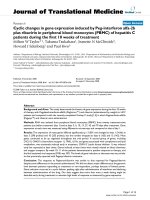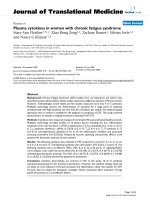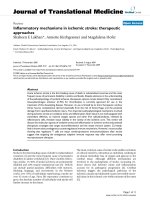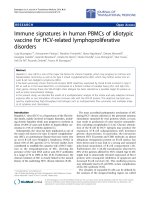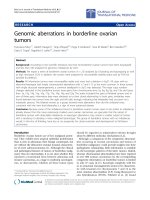Báo cáo hóa học: " Memory effects in annealed hybrid gold nanoparticles/block copolymer bilayers" ppt
Bạn đang xem bản rút gọn của tài liệu. Xem và tải ngay bản đầy đủ của tài liệu tại đây (1008.32 KB, 8 trang )
NANO EXPRESS Open Access
Memory effects in annealed hybrid gold
nanoparticles/block copolymer bilayers
Vanna Torrisi
1*
, Francesco Ruffino
2
, Antonino Licciardello
1
, Maria Grazia Grimaldi
2
, Giovanni Marletta
1
Abstract
We report on the use of the self-organization process of sputtered gold nanoparticles on a self-assembled block
copolymer film deposited by horizontal precipitation Langmuir-Blodgett (HP-LB) method. The morphology and the
phase-separation of a film of poly-n-butylacrylate-block-polyacrylic acid (PnBuA-b-PAA) were studied at the
nanometric scale by using atomic force microscopy (AFM) and Time of Flight Secondary Ion Mass Spectrometry
(TOF-SIMS). The templating capability of the PnBuA-b -PAA phase-separated film was studied by sputtering gold
nanoparticles (NPs), forming a film of nanometric thickness. The effect of the polymer chain mobility onto the
organization of gold nanoparticle layer was assessed by heati ng the obtained hybrid PnBuA-b-PAA/Au NPs bilayer
at T >T
g
. The nanoparticles’ distribution onto the different copolymer domains was found strongly affected by the
annealing treatment, showing a peculiar memory effect, which modifies the AFM phase response of the Au NPs
layer onto the polar domains, without affecting their surfacial composition. The effect is discussed in terms of the
peculiar morphological features induced by enhanced mobility of polymer chains on the Au NPs layer.
Introduction
Recent advanc es in the patterning of polyme rs have
enabled the fabrication of integrated micro- and nano-
systems with high degree o f complexity and functional-
ity. For example, block copolymers have attracted
immense interest for nanotechnology applications
bec ause of easy processability and low-cost fabrications.
The chemically distinct and immiscible polymer blocks
in block copolymers microphase-separate and self-
assemble into ordered patterns on the scale of nan-
ometers [1-3]. This soft nanostructured polymer film
can further be used as a template for patterning of hard
inorganic materials such as metal nanoparticles [4-10].
Metal nanoclusters in a matrix of insulating polymer
have unique physical properties and have been proposed
for optical, electrical and magnetic applications [11-14].
Previous studies demonstrate that metal nanoparti-
cles can preferentially decorate a particular domain in
a diblock copolymer film. In general, the specific nat-
ure of the selective gold-polymer interaction that
causes the self-assembly is still far from being comple-
tely understood.
Patterning of metal nanoparticles within polymer films
has been achieved using four main routes. The first
method is vapour phase co-deposition of polymers/
nanoparticles in high vacuum followed by thermal
annealing [15-18]. Annealing of the polymer film above
the glass transition temperature (T
g
)ofthepolymer
allows structural relaxation of the polymer matrix and
was proven to be responsible for the dispersion of the
metal nanoparticles within the polymer film. The second
method is based on the deposition from a mixture of
block copolymer and organic-coated nanoparticles in
solution onto a solid surface followed by the annealing
step [19-25]. The third method employs the dewetting
of polymer films made from low concentrations of
mixed solutions of polymer and polymer-grafted nano-
particles to create metal nanostructures [26-29]. The
fourth method uses the self-organization characteristic
of evaporated nanoparticles on a self-assembled polymer
film to create nanopatterning by selective adsorption
[30].
We used the sputtering technique to investigate the
deposition behaviour of gold nanoparticles onto block
copolymer template.
* Correspondence:
1
Laboratory for Molecular Surfaces and Nanotechnology (LAMSUN),
Department of Chemical Sciences, University of Catania and CSGI, Viale A.
Doria 6, 95125, Catania, Italy
Full list of author information is available at the end of the article
Torrisi et al. Nanoscale Research Letters 2011, 6:167
/>© 2011 Torrisi et al; licensee Springer. This is an Open Access article distributed under the terms of the Creative Co mmons Attribution
License ( whic h permits unrestricted use, distribution, and reproduction in any medium,
provided the original work is prop erly cited.
Experimental
Substrate cleaning and polymer coating
A silicon wafer 100 (p-type, Boron-doped) was cut into
1×1cm
2
pieces. The silicon substrates were cleaned as
follows: soaking in the cleaning bath at 75°C for 10 min.
The cleaning solution was composed of 100 ml of 96%
NH
4
OH, 35 ml of 35% H
2
O
2
and 65 ml deionized
water. The cleaned substrates were further rinsed in
deionized water for 10 min and finally deposited by hor-
izontal precipitation Langmuir-Blodgett (HP-LB)
method [31].
ACHCl
3
1 mg/ml solution of poly-n-butylacrylate-
block-polyacrylic acid (PnBuA-b-PAA) (MW 13,000 Da)
was used for film deposition by means of HP-LB.
This solution was used for preparation of Langmuir
polymer layers at the water/air interface in a computer-
controlled trough (LT-102, MicrotestMachines, Belarus).
The floating film was compressed at a rate of 0.5 mm/s
(or 0.75 c m
2
/s) and the corresponding isotherms were
acquired. LB films of each mixture (applied pressure
11-14 mN/m) were transferred on cleaned silicon 100
substrates by means of HP-LB method.
Gold nanoparticles sputtering deposition
The depositions were carried out using an RF (60 Hz)
Emitech K550x Sputter coater apparatus onto the sub-
strates and clamped against the cathode located straight
opposite of the Au source (99.999% purity target). The
electrodes were laid at a distance of 40 mm under Ar
flow keeping a pressure of 0.02 mbar in the c hamber.
The deposition time was 30 s with working current of
10 mA, corresponding to about 3 nm of deposited Au.
Annealing treatment
The polymer films were annealed in a vacuum oven at
115°C for 15, 30, 45, 60, 90 min.
Morphological characterization
AFM images were obtained in tapping mode using a
MultiMode Nanoscope IIIa (Digital Instruments, USA).
The device is equipped with a J scanner, which was cali-
brated using th e manufa cturer’s grating. Ultrasharp tips
(Noncon tact “Golden” Silicon cantilevers, NSG10S, typi-
cal force constant 11.5 N/m, resonant frequency
255 kHz) were used. Height images are flattened to
remove background slopes. No other filtering proce-
dures are performed on these images.
Chemical imaging
Static SIMS images were acquired with a TOF-SIMS IV
(ION-TOF), using a pulsed Bi
+
primary ion beam (burst
alignment mode, 25 KeV, 0.5 pA, 100 μm × 100 μm ras-
ter, PI fluence < 3 × 10
11
ions/cm
2
). Detailed images
were obtained from small areas (100 μm × 100 μm with
256 × 256 pixel definition) using the high spatial ima-
gingmode.Thisallowsaspatialresolutionofabout
200 nm; however, mass resolution is greatly degraded.
Analyses below the static limit were performed.
Results and discussion
Figure 1 reports the Langmuir isotherms obtained for
PnBu A-b-PAA films at three different solution concen-
trations, i.e., 1, 3 and 5 mg/ml. The fact that at a given
moleculararea(forinstance7,5nm
2
) the pressure at
3 mg/ml is lower than that one reported in the 1 mg/ml
isotherm is unusual. It depends on the characteristic
behaviour of block copolymers in Langmuir-Blodgett
films and on their pressure-induced reorganization/reor-
ientation phenomena at the air/water interface [32]. The
lower surface pressure for the phase transitions of 3
mg/ml with respect to 1 mg/ml isotherm originates
from chains reorientations of two blocks. Such reorien-
tations are the result of the balance between block-block
and block interface interactions.
In particular, the appearance of a well-defined plateau
region around a surface pressure of 17 mN/m for the
concentration of 5 mg/ml is diagno stic of the formation
of the liquid/solid-like region characteristic of the circu-
lar domains. Accordingly, the 5 mg/ml concentration
corresponds to the critical micellar concentration
(CMC)forthespecificPnBuA-b-PAA employed in this
study [33].
Therefore, in order to obtain a well-pac ked PnBuA-b-
PAA film, the deposition was performed well above the
plateau surface pressure, i.e., at a surface pressure of
25 mN/m. A ccording to wide literature, the structure of
thefilminthesolid-likephaseregionistheresultof
drastic self-assembling processes of t he different poly-
mer blocks, basically yielding circular domains based on
PAA chains, protruded towards the water subphase, and
a matrix based on PnBuA chains, spread at the water/air
interface. The transfer of the films onto solid surfaces
(silicon) by HP-LB method maint ains the lateral inho-
mogeneity of the film structure [31,34,35].
Atomic force microscopy (AFM) measurements of the
films morphology at the microscale are reported in Fig-
ure 2a, showing the characteristic formation of higher
circular domains, corresponding to the micelles pulled
out by the deposition, and a flat matrix, formed by the
PnBuA blocks. The corresponding phase image, sensitive
to the chemical termination of the different regions,
clearly shows the different chemical structure of the
protruding hydrophilic spots, consisting indeed of PAA
blocks, and the flat hydrophobic regions, due to th e
assembly of PnBuA blocks.
Figure 2b shows the effect of the Au sputtering
deposition. One can observe the decrease of the height
of the hydrophilic PAA-based circular domains with
Torrisi et al. Nanoscale Research Letters 2011, 6:167
/>Page 2 of 8
respect to the matrix in the height image, whilst in the
phase image, as expected for the homogeneous Au NP
coating produced, one can observe a uniform and
unstructured image, corresponding to the perfectly
homogeneous coating of Au.
By AFM characterization of the annealed bilayer (Fig-
ure 2c) we have again evidenced of a phase separation.
The nanoparticles’ distribution onto the block copoly-
mer domains, studied by AFM, seems strongly affected
by the bilayer annealing, showing an apparent return of
the initial dephasing of the HP-LB block copolymer
film. Regarding the cause of this return of the dephasing
we can do some hypothesis: (1) Gold segregation onto
the polar domains because of the increased diffusion of
gold onto diblock c opolymer film during the thermal
annealing (higher mobility of gold [36] because of the
higher fluidity of polymer chains) and furthermore due
to new positioning of gold driven by block copolymer
template. (2) The second hypothesis is an in-depth dif-
fusion of gold as Kunz et al. [37] have just observed for
discontinuous gold films on amorphous polymer sub-
strates. In fact amorphous polymers b ehave as viscous
Figure 1 Surface pressure versus molecular area isotherms obtained by 1, 3, 5 mg/ml chloroform solutions of PnBuA-b-PAA.
Figure 2 AFM images of the three steps of sample preparation: (a) HP-LB film of PnBuA-b-PAA; (b) HP-LB film covered with Au
nanoparticles deposited by sputtering; (c) annealed bilayer (115°C, 15 min).
Torrisi et al. Nanoscale Research Letters 2011, 6:167
/>Page 3 of 8
fluids at temperatures above glass transition tempera-
tures and such behaviour could induce an increasing of
the mobility of gold. (3) Third hypothesis implies a
modification of the surface-tip interaction produced by
new hardness or viscoelasticity properties of the upper-
most layer.
In order to exclude the first hypothesis, we consider
the height of circular domains (obtained by section ana-
lysis) versus annealing time. Such a graphic (Figure 3)
shows that the height of circular domains remains con-
stant (〈z〉 = 1.69 nm) after annealing treatment. From
the AFM images the circular domains’ height distribu-
tions were determined by using a software (Nanoscope
IIIa) that defines each circular domains area by the sur-
face image sectioning of a plane that was positioned at
half micelle height. Each height distribution of circular
domains was calculated on a statistical population of 50
circular domains. Each distribution was then fit ted by a
Gaussian function (the continuous line in each figure)
which peak position was taken as the mean value and
which FWHM (full width at half maximum) a s the
deviation on such mean value. The graphic of Figure 3
shows us that annealing process doe s not change circu-
lar domains’ height and this fact allows us to exclude
the first hypothesis: the preferential diffusion of gold
driven by block copolymer template. On the other hand,
the thermodynamic basis of hypotheses 1 and 2 is the
surface-free energy minimization of the hybrid gold/
polymer system. In fact, generally, cluster growth is
regulated by the vapour pressure at the surfaces of the
cluster, P(R), depending on the curvature of the surface
and it is driven by the minimization of the total surface
free energy. For spherical clusters with a radius R,the
vapour pressure at the surface of the cluster is given by
the following relation according to the Gibbs-Thompson
equation [38]
PR P RkT P c R( ) exp( / ) ( / )
21
g
B
(1)
with P
∞
the vapour pressure at a planar surface, g the
surface free energy of gold, Ω the atomic volume of
gold, k
B
the Boltzmann constant, c a temperature-
dependent but time-independent constant and depend-
ing on t he diffusion atomic coefficient D of gold. The
hypothesis 1 involves a surface diffusion of gold on
block copolymer surface c haracterized by a surface dif-
fusion coefficient D
s
. The hypothesis 2 involves, instead,
a diffusion of gold into the polymer characterized by a
diffusion atomic coefficient D
in
of gold in the polymer.
Obviously, usually, D
s
≫ D
in
. Just this purely thermody-
namic consideration supports the exclusion of hypoth-
esis 2. Nevertheles s, for example Kunz [37] observed an
in-depth diffusion of gold in polystyrene after annealing.
Therefore, we performed the step-by-step TOF-SIMS
Figure 3 Heigh t distribution of the micelles after each deposition step of as deposited and annealed samples: Micelles height versus
annealing time (d) and relative height distribution of micelles size of PnBuA-b-PAA film before sputtering (a), after sputtering (b), after thermal
annealing (c).
Torrisi et al. Nanoscale Research Letters 2011, 6:167
/>Page 4 of 8
imaging in order to exclude experiment ally and directly
the first and the second hypotheses.
We have investigated all the three different steps:
(1) HPLB film, (2) hybrid bilayer AuNPs/BCs, (3)
annealed hybrid bilayer.
Figure 4a refers to TOF-SIMS chemical maps of layer
obtained at air/water interface and deposited on SiO
2
/Si
substrate. Figure 4b ref ers to TOF-SIMS chemical maps
of the annealed bilayer composed by HP-LB film of
PnBuA-b-PAA covered with Au nanoparticles deposited
by sputtering. The presence of gold film anneals phase
difference of the hybrid bilayers.
In Figure 4a we observe the results of separ ation phase
phenomena and the pres ence of circular domains in HP-
LB film of PnBuA-b-PAA (Figure 4a). In particular, the
bidimensional distributions of the normalized intensities
of some molecular fragments (m/z:28,29,41,42,57and
197 Da that correspond to CO
+
,CHO
+
,C
2
HO
+
,
C
2
H
2
O
+
,C
4
H
9
+
and Au
+
, respectively) are shown and the
complementarity between PAA molecular fragments
(m/z: 28, 57 Da) and PnBuA molecular fragments (m/z:
29, 41, 42 Da). After gold sputtering deposition we
observe the annealing of inhomogeneous composition of
the film and the homogeneous surface distribution of
gold ion (F igure 4b). Finally, also in Figure 4c the homo-
geneous distributions of all of the fragments are shown.
In summary, TOF-SIMS imaging allows us to exclude
again the first hypothesis, as we know because of the
experimental evidence shown in the graphic of Figure 3,
but allows us to exclude also the second hypothesis
(regarding the in depth diffusion of gold) because we
have no evidence by SIMS imaging of gold depletion
phenomenon and its diffusion under block copolymer
film, in fact we observe an homogeneous distribution of
molecular fragments in the uppermost layer after
annealing (Figure 4c).
Gold nanoparticles layer, shown in AFM images o f
Figure 5, are characterized by a specific value of height
(z = 3.3 nm) obtained with accurate experimental condi-
tions of sputtering deposition. From the AFM images
the Au NPs height distributions were determined by
using a software (Nanoscope IIIa) that define each
nanocluster area by the surface image sectioning of a
plane that was positioned at half cluster height. The
height distribution (Figure 5b inset) of the Au NPs was
obtained on a statistical population of 100 NPs.
Figure 4 ToF SIMS chemica l maps of each deposition step of as deposited and annealed samples: (a) TOF-SIMS chemical maps of the
HP-LB film of PnBuA-b-PAA; (b) TOF-SIMS chemical maps of the HP-LB film of PnBuA-b-PAA covered with Au nanoparticles deposited by
sputtering; (c) TOF-SIMS chemical maps of the annealed bilayer (115°C, 15 min) composed by HP-LB film of PnBuA-b-PAA covered with Au
nanoparticles deposited by sputtering.
Torrisi et al. Nanoscale Research Letters 2011, 6:167
/>Page 5 of 8
By means of the comparison of the nanometric scale
morphology before and after the thermal annealing (Fig-
ure 5b,c) we observe the nanostructures modification
induced by annealing. The new morphology of gold
nanostructures is apparently independent o n the
morphology at the nanoscale of the block copolymer
film as we can deduce by the comparison of Figure 5a
and 5c.
In summary, hybrid bilayer exhibits a memory effect
induced by thermal annealing and these effects can be
Figure 5 Nanometric scale AFM images of each deposition step of as deposited and annealed samples: (a) AFM images in detail (around
micelles) of PnBuA-b-PAA film; (b) AFM images of gold nanoparticles after sputtering deposition, inset: Gaussian distribution of gold
nanoparticles’ size (height). (c) AFM image in detail of annealed (115°C, 15 min) hybrid bilayer with evidence of the modification of gold film
nanostructures.
Torrisi et al. Nanoscale Research Letters 2011, 6:167
/>Page 6 of 8
explained by third hypothesis that takes into account
onl y a modified sur face -tip interaction induced by ther-
mal annealing. Such hypothesis is supported by the
comparison of the nanometric scale morphologies of the
block copolymer film, of hybrid bilayer and annealed
hybrid bilaye r shown in the AFM images of Figure 5. In
fact, after thermal annealing, above T
g
temperatures, of
both of the blocks, the uppermost modified nanostruc-
tured gold layer (shown in Figure 5c), become sensitive
to the immediately underlying block copolymer film,
probably due to the increased diffusion of gold onto
diblock copolymer film during the annealing (higher
mobility of polymer chains). When gold atoms are sp ut-
ter-deposited at room temperature onto insulator sub-
strates they, general ly, grow in the Volmer-Weber mode
forming three-dimensional clusters [39,40]. It is a conse-
quence of the fact that the surface free energy of gold
(1.5 J/m
2
) is higher than that one of the insulator sub-
strates (typically in the range 10-100 mJ/m
2
). In general,
this growth mode for gold on polymers surfaces also
occurs (for example the surface energy of PnBuA is
about 37 mJ/m
2
) [37,41-43]. As a consequence, a low
adhe sion energy (E
d
) for th e gold on polymer substrates
is obtained (with respect to gold deposited on metallic
or semiconductor substrates). Thermal annealing deter-
mines a modification of surface morphology of the gold
nanostructures and an increase of the adhesion energy
of the gold with PnBuA block (E
d1
) and with pAA block
(E
d2
). The differ ent values of E
d1
and E
d2
determine the
interaction modification of the tip with gold on circular
domains (constituted by block 1 PAA) and with gold on
the remaining matrix (constituted by PnBuA) resulting
in the return of two different phases.
Conclusions
The organization of metallic nanoparticles within poly-
mer films can be achieved using many routes. Our
method exploits the self-organization characteristic of
sputtered Au nanoparticles on self-assembled PnBuA-b-
PAA film obtained by HP-LB method. We studied the
morphology and the phase-separat ion of the film before
and after Au sputtering. The effect of the increased
mobility of the polymer chains onto the nanoparticles’
organization has been studied by heating the polymer-
Au bilayer at T >T
g
.
The nanoparticles’ distri bution onto the block copoly-
mer domains, studied by AFM and TOF-SIMS, seems
strongly affected by the bilayer annealing. In particular,
hybrid bilayer s exhibit memory effects as a consequenc e
of thermal annealing. Such effects are proved by mor-
phological and compositional experimental evidence of
Au NPS/Block copolymer hybrid bilayer and can be
explained by the hypothesis that takes into account a
modified surface-tip interaction induced by thermal
annealing. Such hypothesis is supported by the compari-
son of the nanomorphologies of the block copolymer
film, of hybrid bilayer and annealed hybrid bilayer
shown in the AFM images. In fact, after thermal anneal-
ing, above T
g
temperatures of both of the blocks, the
uppermost modified nanostructured gold layer becomes
sensitive to the immediately underlying block copolymer
film, probably due to the increased diffusion of gold
onto diblock copolymer film during the annealing. In
particular, thermal annealing determines a modification
of surface morphology of the gold nanostructures and
an increase of the adhesion energy of the gold w ith
PnBuA block (E
d1
)andwithPAAblock(E
d2
). The dif-
ferent values of E
d1
and E
d2
determine the interaction
modification of the t ip with gold on circular domains
(constituted by block 1 PAA) and w ith gold on the
remaining matrix (constituted by PnBuA) resulting in
the return of two different phases. Furthermore, anneal-
ing at T >T
g
does not induce polymer mixing between
two blocks or between blocks and gold.
Abbreviations
AFM: atomic force microscopy; CMC: critical micellar concentration; HP-LB:
horizontal precipitation Langmuir-Blodgett; NP: gold nanoparticle; PnBuA-b-
PAA: poly-n-butylacrylate-block-polyacrylic acid; TOF-SIMS: time of flight
secondary ion mass spectrometry.
Author details
1
Laboratory for Molecular Surfaces and Nanotechnology (LAMSUN),
Department of Chemical Sciences, University of Catania and CSGI, Viale A.
Doria 6, 95125, Catania, Italy
2
Dipartimento di Fisica e Astronomia and MATIS
CNR-IMM, Università di Catania, Via S. Sofia 64, 95123, Catania, Italy
Authors’ contributions
VT: conceived of the study, and participated in its design and coordination;
carried out the diblock copolymer film deposition, the ToF SIMS imaging
and the atomic force microscopy characterization; interpreted and analyzed
the experimental data; drafted the manuscript. FR conceived of the study,
and participated in its design; carried out the gold sputter deposition and
the annealing processes; participated in the interpretation of the
experimental data; contributed in drafting the manuscript. AL participated in
the ToF SIMS characterization and in helpful scientific discussion about data
interpretation. MGG conceived of the study, and participated in its design;
participated in the interpretation of the experimental data; contributed in
drafting the manuscript. GM conceived of the study, and participated in its
design and coordination; participated in the interpretation of the
experimental data; contributed in drafting the manuscript.
All authors read and approved the final manuscript.
Competing interests
The authors declare that they have no competing interests.
Received: 6 September 2010 Accepted: 23 February 2011
Published: 23 February 2011
References
1. Xia YN, Kim E, Zhao XM, Rogers JA, Prentiss M, Whitesides GM: “Complex
optical surfaces formed by replica molding against elastomeric masters”.
Science 1996, 273:347.
2. Quake SR, Scherer A: “From micro- to nanofabrication with soft
materials”. Science 2000, 290:1536.
3. Schmitt J, Decher G, Dressick WJ, Brandow SL, Geer RE, Shashidhar R,
Calvert JM: “Metal nanoparticle/polymer superlattice films: Fabrication
and control of layer structure”. Adv Mater 1997, 9:61.
Torrisi et al. Nanoscale Research Letters 2011, 6:167
/>Page 7 of 8
4. Krishnan RS, Mackay ME, Duxbury PM, Pastor A, Hawker CJ, Van Horn B,
Asokan S, Wong MS: “Self-assembled multilayers of nanocomponents”.
Nano Lett 2007, 7:484.
5. Tjandra W, Yao J, Ravi P, Tam KC, Alamsjah A: “Nanotemplating of calcium
phosphate using a double-hydrophilic block copolymer”. Chem Mater
2005, 17:4865.
6. Thurn-Albrecht T, Schotter J, Kastle CA, Emley N, Shibauchi T, Krusin-
Elbaum L, Guarini K, Black CT, Tuominen MT, Russell TP: “Ultrahigh-density
nanowire arrays grown in self-assembled diblock copolymer templates”.
Science 2000, 290:2126.
7. Lu JQ, Yi SS: “Uniformly sized gold nanoparticles derived from PS-b-P2VP
block copolymer templates for the controllable synthesis of Si
nanowires”. Langmuir 2006, 22:3951.
8. Minelli C, Hinderling C, Heinzelmann H, Pugin R, Liley M: “Micrometer-long
gold nanowires fabricated using block copolymer templates”. Langmuir
2005, 21:7080.
9. Horiuchi S, Fujita T, Hayakawa T, Nakao Y: “Three-dimensional nanoscale
alignment of metal nanoparticles using block copolymer films as
nanoreactors”. Langmuir 2003, 19:2963.
10. Adachi M, Okumura A, Sivaniah E, Hashimoto T: “Incorporation of metal
nanoparticles into a double gyroid network texture”. Macromolecules
2006, 39:7352.
11. Black CT, Murray CB, Sandstrom RL, Sun SH: “Spin-dependent tunneling in
self-assembled cobalt-nanocrystal superlattices”. Science 2000, 290:1131.
12. Sanchez C, Julian B, Belleville P, Popall M: “Applications of hybrid organic-
inorganic nanocomposites”. J Mater Chem 2005, 15:3559.
13. Sanchez C, Lebeau B: “Design and properties of hybrid organic-inorganic
nanocomposites for photonics”. MRS Bull 2001,
26:377.
14. Roth SV, Walter H, Burghammer M, Riekel C, Lengeler B, Schroer C,
Kuhlmann M, Walther T, Sehrbrock A, Domnick R, Müller-Buschbaum P:
“Combinatorial investigation of the isolated nanoparticle to coalescent
layer transition in a gradient sputtered gold nanoparticle layer on top of
polystyrene”. Appl Phys Lett 2006, 88:021910.
15. Takele H, Schurmann U, Greve H, Paretkar D, Zaporojtchenko V, Faupel F:
“Controlled growth of Au nanoparticles in co-evaporated metal/polymer
composite films and their optical and electrical properties”. Eur Phys J
Appl Phys 2006, 33:83.
16. Biswas A, Marton Z, Kanzow J, Kruse J, Zaporojtchenko V, Faupel F,
Strunskus T: “Controlled generation of Ni nanoparticles in the capping
layers of Teflon AF by vapor-phase tandem evaporation”. Nano Lett 2003,
3:69.
17. Biswas A, Aktas OC, Kanzow J, Saeed U, Strunskus T, Zaporojtchenko V,
Faupel F: “Polymer-metal optical nanocomposites with tunable particle
plasmon resonance prepared by vapor phase co-deposition”. Mater Lett
2004, 58:1530.
18. Kay E: “Synthesis and properties of metal-clusters in polymeric matrices”.
Z Phys D 1986, 3:251.
19. Lauter-Pasyuk V, Lauter HJ, Ausserre D, Gallot Y, Cabuil V, Hamdoun B,
Kornilov EI: “Neutron reflectivity studies of composite nanoparticle
copolymer thin films”. Phys B 1998, 248:243.
20. Lin Y, Boker A, He JB, Sill K, Xiang HQ, Abetz C, Li XF, Wang J, Emrick T,
Long S, Wang Q, Balazs A, Russell TP: “Self-directed self-assembly of
nanoparticle/copolymer mixtures”. Nature 2005, 434:55.
21. Hamdoun B, Ausserre D, Joly S, Gallot Y, Cabuil V, Clinard C: “New
nanocomposite materials”. J Phys II 1996, 6:493.
22. Lauter-Pasyuk V, Lauter HJ, Gordeev GP, Müller-Buschbaum P, Toperverg BP,
Jernenkov M, Petry W: “Nanoparticles in block-copolymer films studied
by specular and off-specular neutron scattering”. Langmuir 2003, 19:7783.
23. Frömsdorf A, Kornowski A, Putter S, Stillrich H, Lee LT: “Highly ordered
nanostructured surfaces obtained with silica-filled diblock-copolymer
micelles as templates”. Small 2007, 3:880.
24. Hashimoto T, Harada M, Sakamoto N: “Incorporation of metal
nanoparticles into block copolymer nanodomains via in-situ reduction
of metal ions in microdomain space”. Macromolecules 1999, 32:6867.
25. Jain A, Hall LM, Garcia CBW, Gruner SM, Wiesner U: “Flow-induced
alignment of block copolymer-sol nanoparticle coassemblies toward
oriented bulk polymer-silica hybrids”. Macromolecules 2005, 38:10095.
26. Abul Kashem MMA, Perlich J, Schulz L, Roth SV, Petry W, Müller-
Buschbaum P: “Maghemite nanoparticles on supported diblock
copolymer nanostructures”. Macromolecules 2007, 40:5075.
27. Barnes KA, Karim A, Douglas JF, Nakatani AI, Gruell H, Amis EJ: “Suppression
of dewetting in nanoparticle-filled polymer films”. Macromolecules 2000,
33:4177.
28. Barnes KA, Douglas JF, Liu DW, Karim A: “Influence of nanoparticles and
polymer branching on the dewetting of polymer films”. Adv Colloid
Interface Sci 2001, 94:83.
29. Krishnan RS, Mackay ME, Duxbury PM, Hawker CJ, Asokan S, Wong MS,
Goyette R, Thiyagarajan P: “Improved polymer thin-film wetting behavior
through nanoparticle segregation to interfaces”. J Phys: Condens Matter
2007, 19:356003.
30. Lopes WA: “Nonequilibrium self-assembly of metals on diblock
copolymer templates”. Phys Rev E 2002, 65:031606.
31. Zhavnerko GK, Staroverov VN, Agabekov VE, Gallyamov MO, Yaminsky IV:
“Interpretation of SPM images of Langmuir-Blodgett films based on
long-chain carboxylic acids”. Thin Solid Films 2000, 359:98.
32. Li S, Hanley S, Khan I, Varshney SK, Eisenberg A, Lennox RB: “Surface
micelle formation at the air-water-interface from non-ionic diblock
copolymers”. Langmuir 1993, 9:2243.
33. Eghbali E, Colombani O, Drechsler M, Axel HE, Müller AHE, Hoffmann H:
“Rheology and phase behavior of poly(n-butyl acrylate)-block-poly
(acrylic acid) in aqueous solution”. Langmuir 2006, 22:4766.
34. Torrisi V, Tuccitto N, Delfanti I, Audinot JN, Zhavnerko GK, Migeon HN,
Licciardello A: “Nano- and microstructured polymer LB layers: A
combined AFM/SIMS study”. Appl Surf Sci 2008, 255:1006.
35. Torrisi V, Licciardello A, Marletta G: “Chemical imaging of self-assembling
structures in Langmuir-Blodgett films of polymer blends”. Mater Sci Eng B
2010, 169:49.
36. Ruffino F, Torrisi V, Marletta G, Grimaldi MG: “Kinetic growth mechanisms
of sputter-deposited Au films on mica: from nanoclusters to
nanostructured microclusters”. Appl Phys A 2010, 100:7.
37. Kunz MS, Shull KR, Kellock AJ: “Morphologies of discontinuous gold-films
on amorphous polymer substrates”. J Appl Phys 1992, 72:4458.
38. Tu KN, Mayer JW, Feldman LC: Electronic Thin Film Science New York:
Macmillan Publishing Company; 1992.
39. Campbell CT: “Ultrathin metal films and particles on oxide surfaces:
Structural, electronic and chemisorptive properties”. Surf Sci Rep 1997,
27:1.
40. Venables JA, Spiller GDT, Hanbüken M: “Nucleation and Growth of thin
films”. Rep Prog Phys 1984, 47:399.
41. Smithson RLW, McClure DJ, Evans DF: “Effects of polymer substrate
surface energy on nucleation and growth of evaporated gold films”.
Thin Solid Films 1997, 307:110.
42. Kaune G, Ruderer MA, Metwalli E, Wang W, Couet S, Schlage K,
Röhlsberger R, Roth SV, Müller-Buschbaum P: “In Situ GISAXS Study of
Gold Film Growth on Conducting Polymer Films”. Appl Mater Interfaces
2009, 1:353.
43. Mark JE, (Ed): Physical properties of Polymers-Handbook. 2 edition. New York:
Springer; 2007, 1012.
doi:10.1186/1556-276X-6-167
Cite this article as: Torrisi et al.: Memory effects in annealed hybrid gold
nanoparticles/block copolymer bilayers. Nanoscale Research Letters 2011
6:167.
Submit your manuscript to a
journal and benefi t from:
7 Convenient online submission
7 Rigorous peer review
7 Immediate publication on acceptance
7 Open access: articles freely available online
7 High visibility within the fi eld
7 Retaining the copyright to your article
Submit your next manuscript at 7 springeropen.com
Torrisi et al. Nanoscale Research Letters 2011, 6:167
/>Page 8 of 8
